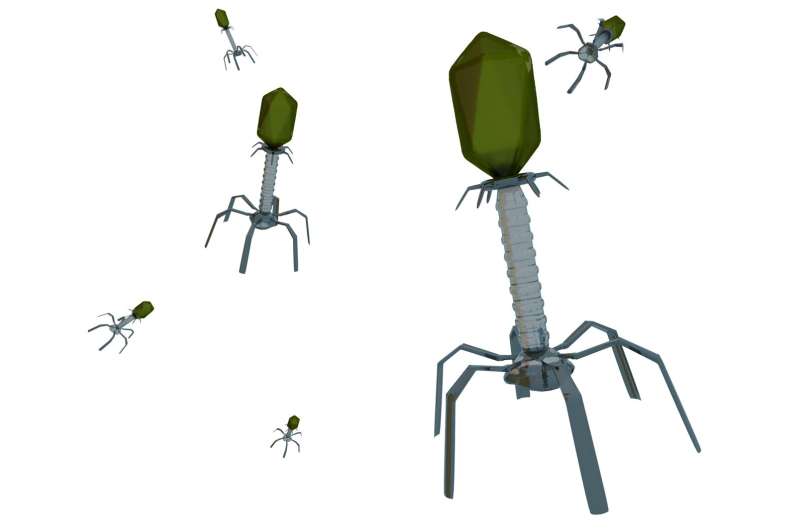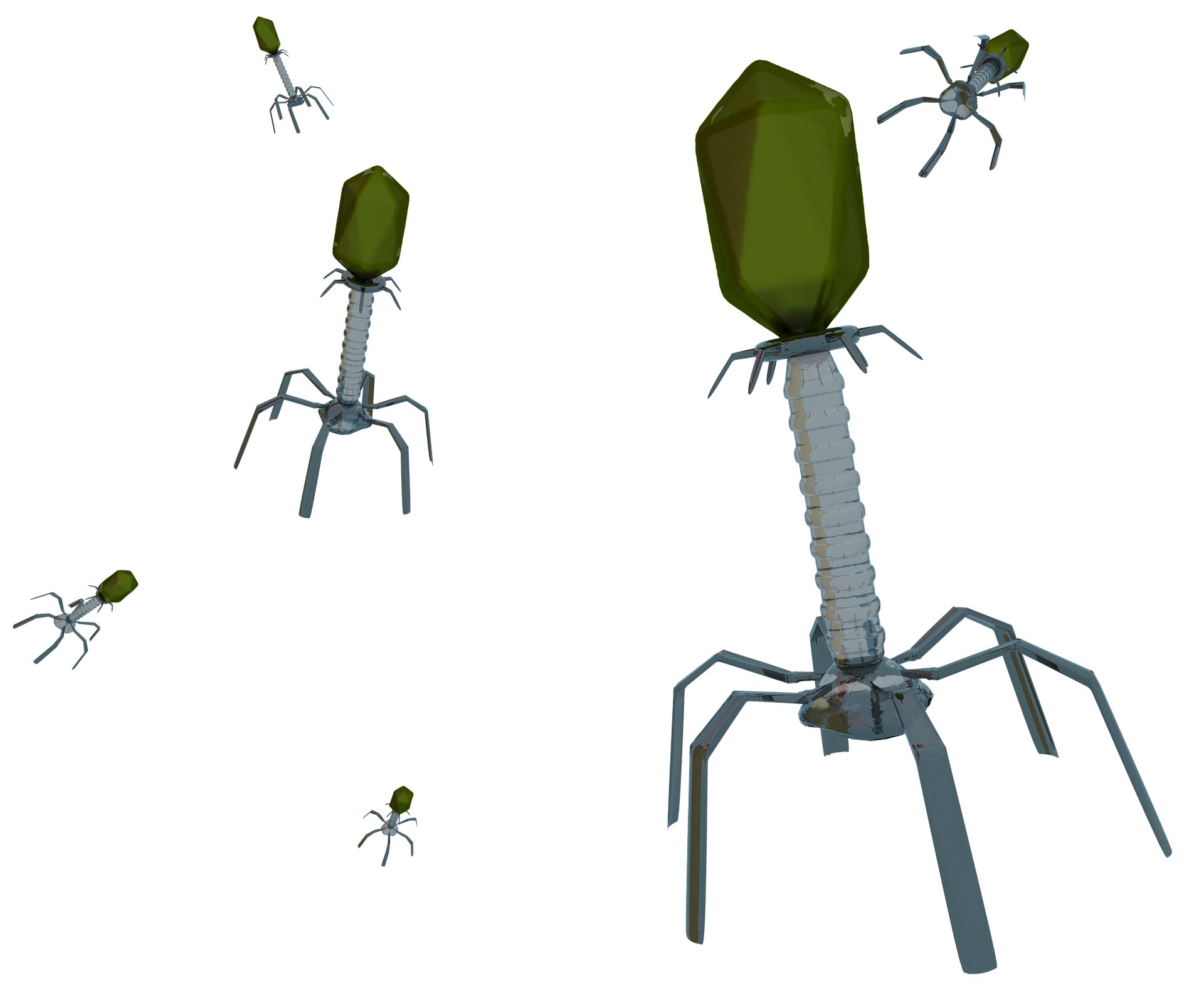
Credit: Public Domain Pixabay/CC0
Bacteriophages, viruses that attack and destroy bacteria, are ubiquitous in the natural world where they play a vital role in regulating microbial populations in ways that are not yet well understood.
New research led by the University of Utah and University College London (UCL) has found that bacterial plant pathogens are able to reuse elements of their bacteriophages, or phages, to eradicate competing microbes.
These surprising findings suggest that such phage-derived elements may one day be used as an alternative to antibiotics, according to Talia Karasov, an assistant professor in the School of Biological Sciences at the U. The study, titled “A phage tail-like bacteriocin suppress competitors in metapopulations of pathogenic bacteria”, was published in science.
This result was not what she expected to find when she began this research with an international team of scientists.
Microbial pathogens are around, but only part of the time they make people, animals or other plants sick, according to Karasov, whose main research interest is in the interactions between plants and microbial pathogens. The Karasov lab is seeking to understand the factors that lead to disease and epidemics versus keeping pathogens under control.
For its previous research, the lab looked at how a particular bacterial pathogen, Pseudomonas viridiflava, manifests itself in agricultural and wild environments. In cultivated soil, they found, one variant would spread widely across a planted field and become the dominant microbe present. But this was not the case in the fallow lands, prompting Karasov to find out why.
“We see that no single lineage of bacteria can dominate. We wonder if phages, the pathogens of our bacterial pathogens, can prevent single lineages from spreading—perhaps the phages were killing some strains and not others. That’s where the study began ours, but this is not where it ended”, said Karasov.
“We looked at the genomes of bacterial plant pathogens to see which phages were infecting them. But it wasn’t phage that we found interesting. The bacteria had taken a phage and repurposed it to fight other bacteria, now using it to kill competing bacteria”.
According to her study, the pathogen acquires phage elements in the form of non-replicating clusters of reused phage called tailocins, which penetrate the outer membranes of other pathogens and kill them.
After discovering this ongoing war in bacterial pathogen populations, the Karasov lab and Hernán Burbano’s lab at UCL mined the genomes of modern and historical pathogens to determine how bacteria evolve to target each other.
“You can imagine an arms race between bacteria where they’re trying to kill each other and trying to develop resistance to each other over time,” Burbano said. “The herbarium specimens from the past 200 years that we analyzed provided a window into this arms race, providing insight into how bacteria avoid being killed by their competitors.”
Mining herbarium specimens for their microbial DNA
Burbano pioneered the use of herbarium specimens to explore the evolution of plants and their microbial pathogens. His lab is sequencing the genomes of both host plants and those of microbes associated with the plant at the time of collection more than a century ago.
For the phage research, Burbano analyzed historical specimens of Arabidopsis thaliana, a plant in the mustard family commonly called thalassemia, collected in southwestern Germany, comparing them and the microbes they harbored to plants growing today in the same part of the world. Germany.
“We found that all historical tylocines were present in our present-day data, suggesting that evolution has maintained the diversity of tylocine variants over the century scale,” he said. “This likely indicates a limited set of potential resistance/susceptibility mechanisms within our studied bacterial population.
Lead author Talia Backman asks whether tailocins could help solve the looming crisis in antibiotic resistance seen in harmful bacteria that infect humans.
“We as a society are in dire need of new antibiotics, and tailocins have potential as new antimicrobial treatments,” said Backman, a graduate student in the Karasov lab.
“While tylocins have previously been found in other bacterial genomes and studied in laboratory settings, their impact and evolution in wild bacterial populations was unknown. The fact that we discovered that these wild plant pathogens all have tylocins and these tylocins are evolving. killing neighboring bacteria shows how important they can be in nature.”
Like most pesticides, many of our antibiotics were developed decades ago to kill a wide range of harmful organisms, both harmful and beneficial to human and plant health. Tailocins, on the other hand, have greater specificity than most modern antibiotics, killing only certain types of bacteria, suggesting they can be distributed without laying waste to entire biological communities.
“This is basic research at this point, not yet ready for application, but I think there’s good potential that this could be adapted to treat infection,” Karasov said.
“We as a society, in the way we treat pests in agriculture and bacterial pathogens in humans, have used uniform, broad-spectrum treatments. Tylocin’s kill specificity is one way you can imagine making treatments more tailored.”
Research participants with the U School of Biological Sciences were University College London, the Max Planck Institute for Biology, the Complex Carbohydrate Research Center of the Analytical Services and Training Laboratory at the University of Georgia, New York University, the Department of Biochemistry at the U. and Lawrence Berkeley National Laboratory.
More information:
Talia Backman et al, A phage tail-like bacteriocin suppresses competitors in metapopulations of pathogenic bacteria, science (2024). DOI: 10.1126/science.ado0713. www.science.org/doi/10.1126/science.ado0713
Provided by University of Utah
citation: Research reveals plant pathogens repurpose phage elements for bacterial warfare (2024, June 13) Retrieved June 14, 2024 from https://phys.org/news/2024-06-reveals-pathogens-repurpose-phage-elements. html
This document is subject to copyright. Except for any fair agreement for study or private research purposes, no part may be reproduced without written permission. The content is provided for informational purposes only.
